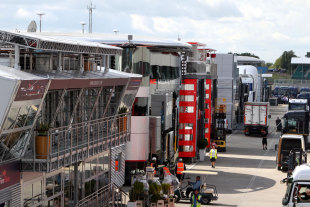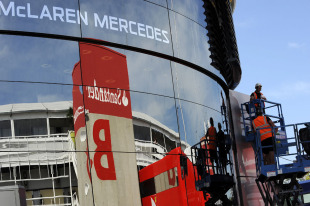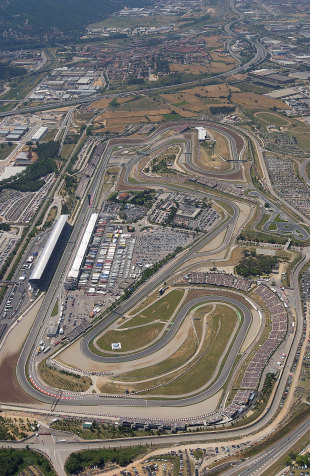
- Race:
- Spanish Grand Prix
Barcelona is significant because it opens the European sector of the F1 season. For the teams, this provides the first opportunity to show off the latest motor homes that will act as temporary headquarters for this weekend and other grands prix within striking distance by road.
'Motor home' and 'temporary' are non-sequiturs in this instance. Long gone are the days when teams thought they were doing the business by bringing a fancy Winnebago motor home to the race track. These Recreational Vehicles (to give the original American title) were unquestionably a step up from tiny caravans that you wouldn't be seen dead in these days if parked in any self-respecting holiday resort. But the term motor home has since become a euphemism for a smoked glass palace that brings new meaning to the word 'flash' or, in one or two instances, 'brash'. And Barcelona is where we get to see the latest bout of F1 willy-waving.
There was a time when space was severely restricted as F1 paddocks coped with as many as 18 teams. But a reduction in entry and an increase in the dimensions and surface quality of your standard Ecclestone paddock mean that teams have been allowed room to gradually expand horizontally as well as vertically.
If Red Bull brought razzamatazz with their Energy Station by combining and maximising the allocated paddock space for both this team and Toro Rosso, McLaren introduced smoked-glass sophistication with their so-called Brand Centre, with its three floors and a front facade of 13.5 metres of environmentally friendly solar glass that takes approximately 20 people two days to erect.

No one complains, of course, because the advent of such comfort and convenience means the luxury of choosing which team provides the best mid-morning Cappuccino (a toss-up between Red Bull and Mercedes, with the latter getting the nod thanks to the supply of excellent chocolate cookies.) A far cry, this, from having to queue at a suspect Belgian hamburger van at the back of the Zolder paddock 30 years ago.
Barcelona is a F1 home-from-home in more ways than one. Having tested over the winter at this track, the drivers and their engineers know the Circuit de Cataluña like the back of their hands. But at least the end of pre-race testing has done away with the farce of turning up for practice on Friday and nothing happening because the know-it-all teams felt it wasn't worth the waste of engine miles and energy.
At least when faced with boredom, it is a quick commute by train (there is a station at the track) to the centre of Barcelona and all of its beautiful attractions. That said, staying in the city has become hugely expensive in recent years, not just because of the value of the Euro against Sterling and the US Dollar, but also because of what appears to be extortionate profiteering by the hotels - particularly during the easy pickings at grand prix time.
In any case, the city is not ideal if commuting by road. On a good day, a 30-minute dash will get you there but the arrival of Fernando Alonso as prospective World Champion 10 years ago means good days have become mired in traffic. And, truth be told, the environment is not particularly attractive when you get there.

Apart from sweeping past a cement factory close by the motorway, the journey leads you to an industrial estate, the off-ramp being recognised by four giant spherical gas cylinders, the nick-names for which require little guesswork and do not need repeating on a respectable website.
They're not easy to miss but, saying that, it's amazing how the world can pass you by when deep in conversation and not familiar with the surroundings when driving from the airport on the first day.
A couple of years ago, two British national newspaper journalists were so engrossed in discussion that the error of their ways and map reading was signalled by the unexpected appearance of the border with Andorra. To add insult to injury and having explained their predicament to the toll booth official, the man - who was clearly bored and having a bad day - insisted they pay their seven Euros and make a u-turn around the booth, whereupon he swivelled his chair to the opposite window, slid it open and cheerfully charged them another seven Euros for the return journey. This did little for Anglo-Spanish relations and evoked much angry imitation of Basil Fawlty berating his hapless Spanish waiter, Manuel.
There are hotels close by the circuit but to stay there is to have convenience at the expense of mind-numbing boredom in two-star hospitality with an industrial park view at no extra charge. The answer is to locate at somewhere such as Mataro; a quick blast over the hills on the coast. Here you can enjoy local hospitality and specialities such as a massive bowl of sea food paella washed down with a nice Rioja. Worth looking for. Even if you do have to go via Andorra.
Maurice Hamilton writes for ESPN F1 in the build-up to each Grand Prix.
© ESPN Sports Media Ltd.
 Maurice Hamilton writes for ESPN F1. A veteran journalist in the paddock, Maurice Hamilton has been part of the Formula One scene since 1977 and was the Observer's motor racing correspondent for 20 years. He has written several books as well as commentating on Formula One for BBC Radio 5 Live
Maurice Hamilton writes for ESPN F1. A veteran journalist in the paddock, Maurice Hamilton has been part of the Formula One scene since 1977 and was the Observer's motor racing correspondent for 20 years. He has written several books as well as commentating on Formula One for BBC Radio 5 Live

